List of Folk & Classical Dance Form In India – State wise PDF Download
India is land of varied traditional and cultural. Diversity in all sphere make the India quite unique. Each state in India and region of a unique way of life and celebration and traditional. More you explore, more you will realise although they all tell the same story. What’s truly magical is how they still different from each other. Let’s take a walk through various Folk dance from various part of India.
What is a Dance?
♦ Physical expression of emotive content of music
=> “Gestures coupled with rhythmical movements to expressions can be defined as Dance”
=> Expression of mind through body movements
=> In ancient culture dance was purely for religious practices, in modern society-entertainment.
♦ Pleasure of dancing is in watching that music through the visual expression.
♦ Literary work which gives information about ‘Natyasasthra’ by Bharata muni.
Categories of Dances
1. Classical Dances
2. Folk Dances
Technique of Dance
According to Sangeetharatnakara and Abhinayadarpana, dancing has 3 parts.
NATYA – corresponds to drama
NRITT – pure dance – movement of body do not express any mood and do not convey any meaning.
NRITHYA – or Abhinaya – along with NATYA.
Indian Classical Dances
According to Sangeet natak academy, 8 dances –
Bharatanatyam
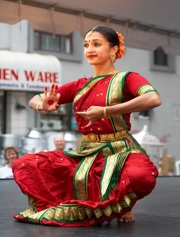
Bharatanatyam is poetry in motion, a solo dance originating in temples of south India. It is based on the principles of ‘Natya Shastra’, written by the great sage, Bharata, around 4000 BC. Earler, it was traditional dance performed to repertory of carnatic varnam, padam, thillana and so on. Its present form was evolved in Tanjore by Ponniah Pillai and brothers. Smt. Rukmini Devi gave it a new life and respectively. On par with her was T. Bala Saraswathi, the queen of Bharatanatyam.
- Dance form of Tamilnadu
- ‘Bha’ stands for Bhava which is mood. ‘Ra’ for Raga = music. ‘Ta’ for Tala = rhythm
- Natam stands for Nritya.
Mohiniyattam
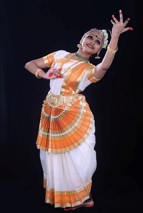
A solo dance form from Kerala, Mohiniattam is also the heir to Devadasi dance heritage like Bharatanatyam, Odissi and Kuchipudi. In the 19th Century, the king of Travancore, Swati Tirunal encouraged this dance form. Poet Vallathol revived it through Kerala Kalamanadalam founded by him in 1930 along with Kalamanadalam Kalyaniamma, the first dance teacher of Kalamandalam.
- Originated in Kerala.
- Perfromed only by Women
- Derives it’s name from Mohiniof Puranas
- It has elements of Bharatanatyam and Kathakali
Kathakali
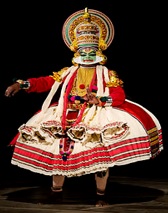
This dance form is from Kerala which is more dramatic than narrative in form. It has its origin in the courts of the kings of Kerala and is considered to be the most scientific and elaborately defined dance form. The body gestures, hand movements and eye/eyeball movements comprise its language. It is not a folk dance but is highly classical, though not very old. Poet Vallathol revived Kathakali in its present form.
- Dance drama of Kerala
- Born in the temples of Kerala
- Performed in open air, in nights
- Themes – epics
- Katha will recite in music by a singer accompanied by drums and musical instruments.
- Actor never open his lips.
- Movement of body, facial expression and art of hands interpret.
Kathak
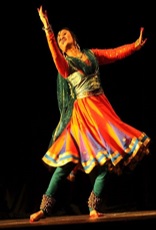
This dance form originated in U.P., Rajasthan. It has its roots in “Katha” meaning story. The story tellers who were attached to the temples in North India, narrated stories from the Epics, in the form of Radha and Krishnalilas. With the advent of Muslim rule, it came out ofthe temples in the form of a sphisticated dance of the Mughal courts. The Nawabs of the erstwhile small kingdoms patronised this dance form which drifted from a pure dance into erotics. Binda Din Maharaj, Kalkadin, Achchan Maharaj, Gopi Krishna and Birju Maharaj are some of the greatest exponents of Kathak.
- Dance form of North (mainly of U.P.)
- Derives it’s name from kathaka which means story teller.
- He recites from epics with gestures and music.
- Gradually it assumed an elaborate involving Nritt and Nrithya.
- Under Mughal rulers, it was influenced Persian customs and style of dance.
- Starts with soft and varied movements.
- Concluding with fast foot movements and jumps and turns.
- Male dancer usually wear sharvani and velvet cap.
- He ties bells around his ankles.
- Male or female dancers or even as couple dance.
Odissi
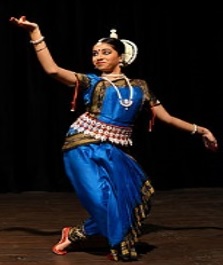
Odissi is a dance form developed in Orissa during the second century BC when the Jain King Kharavela ruled. He himself was an expert dancer. It is also based on the principles of ‘Natya Sastra’. Themes from Jayadeva’s ‘Gita Govinda’, poems in praise of Krishna written around the AD12 Century dominate the contents. First performed by women called ‘Maharis’ in the Jagannath Temple (Puri) and then by young boys attired as women called gotipuas’, Odissi is woven around the basic tribhanga pose typical of Indian sculpture. It has gained popularity today and the credit goes to Smt. Samjukta Panigrahi who gave it an universal appeal. The name of Guru Kelucharan Mahapatra is at the forefront of the greatest exponents of odissi.
- Dance form of Orissa
- As devotion to lord Krishna
- Based on ‘Greethagovinda’
- Used to depict love and devotion to God.
- It was originally temple art, later performed in royal courts.
- Mudras and expressions are singer of Bharatanatyam.
Kuchipudi
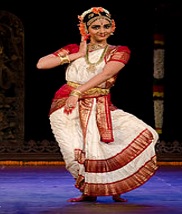
It is a solo dance popular in Andhra Pradesh. It is originated in a place called “Kuchelapur” Tirtha Narayana and Siddendra Yogi evolved this style. Traditionally performed by men attired like women, it has a style which corresponds with Bhagavata Mela Natak of Tamil Nadu. Except for the emphasis on animation, it draws upon the principles of the Natya Sastra and in all other aspects it is akin to Bharatanatyam. Vedntham Sayanarayana is the doyen of Kuchipudi. China Satyam is a renowed guru of this dance form.
- Dance originated in Kuchipudi, Andhra Pradesh
- Traced back to dance drama of enacted by Brahmanas in temples.
- Theme – Bhagavat Purana especially life of Krishana.
- Famous thing is dancing up on brass plate and pot on his head.
- Performed both as solo and in group.
Manipuri
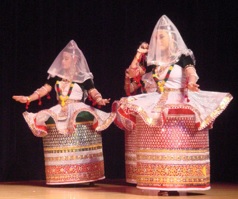
Manipuri is a dance form, mostly ritualistic, popular in the ‘north-east’. The ragas comprise five different types of ballets based on Radha-Krishna-Gopis theme. The other form of this dance is the “Sankirtanas”, usually performed by men carrying drums called ‘pung’. It is a highly lyrical dance but lacks dramatic facial and gestural epression.
- Dance of Manipur
- Describe the plays of Krishna and Gopikas
- Body moves with slow and grace arm movements and movements of fingers.
Sattriya
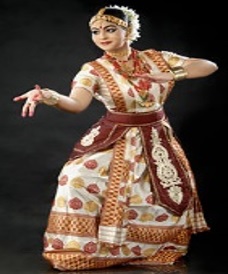
- Assam
- Originated in 15th century by Sankardev
- Performed in SATTRAS (monasties) originally by males.
- Now by females too.
- Accompanied with musical compositions by sankardev.
Chakiarkoothu
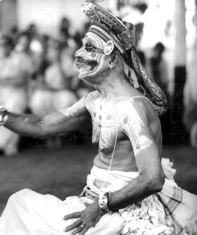
This dance form is believed to have been introduced to Kerala by the earlier Aryan immigrants. Its performance is restricted to the members of Chakiar caste. It is a highly orthodox form of entertainment which is performed inside the temples and is witnessed by Hindus of the higher castes only.
Ottam Thullai
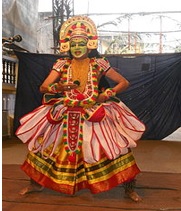
It is also a solo dance form of Kerala, known as poor man’s Kathakali. The dialogue is in simple Malayalam and therefore has a mass appeal. Kunjan Nambiar evolved it to bring out the social conditions of his time, the distinctions of class, and the whims and weaknesses of the rich.
Yakshagana
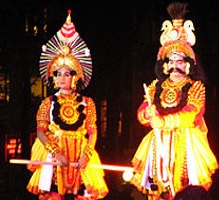
It is a dance-drama from Karnataka which is of rural origin. the language is Kannada and theme based on the hindu epics. It is about 400 years old. It was revived by Dr. Shivaram Karanth.
Folk Dances
- Folk comprises common people
- Folk dance is common people’s dance.
- They are simple, natural and spontaneous expression of every day themes and feeling.
- Language is very simple and local.
Difference between Classical Dance and Folk Dance
| Classical Dance | Folk Dance |
| No. of participants – more, primarily solo | group |
| Language – literary language | Local |
| Dress – elaborate structure, colour and ornamentation | Simple |
| Format – artificial atmosphere, Theme – mythological, Audience participation | Natural |
| Audience can only enjoy | Audience can participate |
Indian folk and tribal dances are simple dances and are performed to express joy and happiness among themselves. Folk and tribal dances are performed for every possible occasion, to celebrate the arrival of seasons, birth of a child, a wedding and festivals. The dances are extremely simple with minimum of steps or movements.
Famous Folk Dances with Their States
| Dance | State |
| Ankia Nat | Assam |
| Bahaka Wata | Orissa |
| Bhangra | Punjab |
| Bhavai | Gujarat, Rajasthan |
| Bidesie | Bihar |
| Bihu | Assam |
| Chakiarkoothu | Kerala |
| Chakri | Jammu and Kashmir |
| Chamar Givad | Rajasthan |
| Chappeli | Uttar Pradesh |
| Chhau | West Bengal |
| Chavittu Natakam | Kerala |
| Chiraw (bamboo dance) | Mizoram |
| Dahikala | Maharashtra |
| Dandanate | Orissa |
| Dandiya Ras | Gujarat |
| Gangore | Rajasthan |
| Garba | Gujarat |
| Gidda | Punjab |
| Gidda Parhaun | Himachal Pradesh |
| Hikat | Jammu and Kashmir |
| Jata-Jatin | Bihar |
| Jatra | West Bengal |
| Jhulan Leela | Rajasthan |
| Jhummar or Ghumar | Rajasthan |
| Kaikotti kali | Kerala |
| Kummi | Tamil Nadu |
| Kajri | Uttar Pradesh |
| Kayanga | Himachal Pradesh |
| Karan | Uttar Pradesh |
| Kathi | West Bengal |
| Kayanga Bajavanga | Rajasthan |
| Khayal | Rajasthan |
| Krishnavattam | Kerala |
| Kumaon | Uttar Pradesh |
| Lai Haroba | Manipur |
| Lavani | Maharashtra |
| Lezim | Maharashtra |
| Lota | Madhya Pradesh |
| Luddi | Himachal Pradesh, Punjab |
| Maach | Madhya Pradesh |
| Maha Rasa | Manipur |
| Mudiyttu | Kerala |
| Nautanki | Uttar Pradesh |
| Ojapali | Assam |
| Pandvani | Madhya Pradesh |
| Raslila | Gujarat |
| Rauf | Jammu and Kashmir |
| Swang | Haryana |
| Tamasha | Maharashtra |
| Tappatri Kali | Kerala |
| Therukkthu | Tamil Nadu |
| Theyyam | Kerala |
| Tippani | Gujarat |
| Veedhi Bhagavatam | Andhra Pradesh |
| Wangala Laho | Meghalaya |
List of Folk & Classical Dance Form In India – State wise PDF Download
Candidates can download the list of folk dance and classical dance form in India by clicking on below link.
List of Folk & Classical Dance Form In India – State wise PDF Download
If you have still any doubt about any dance, please comment below in box. We will make article on that dance too.
All the best for your upcoming exam!
You can join or visit at Facebook Page or Twitter for always keep in touch with further updates.
Read more articles….

Thanks for providing such important information.
Hi Anurag Tripathi, We Will Upload Soon..